Project Management Report
VerifiedAdded on 2023/06/15
|15
|2650
|356
AI Summary
This report covers various aspects of project management including risk management, stakeholder identification, team development, project budget calculation, network diagram and more. It includes a flow chart for college admission process, Tuckman's 5 stages of team development, 3 project control methods, and a case study of XYZ Airline's project. The report also provides solutions to project cases and a network diagram with alternative paths and critical path.
Contribute Materials
Your contribution can guide someone’s learning journey. Share your
documents today.
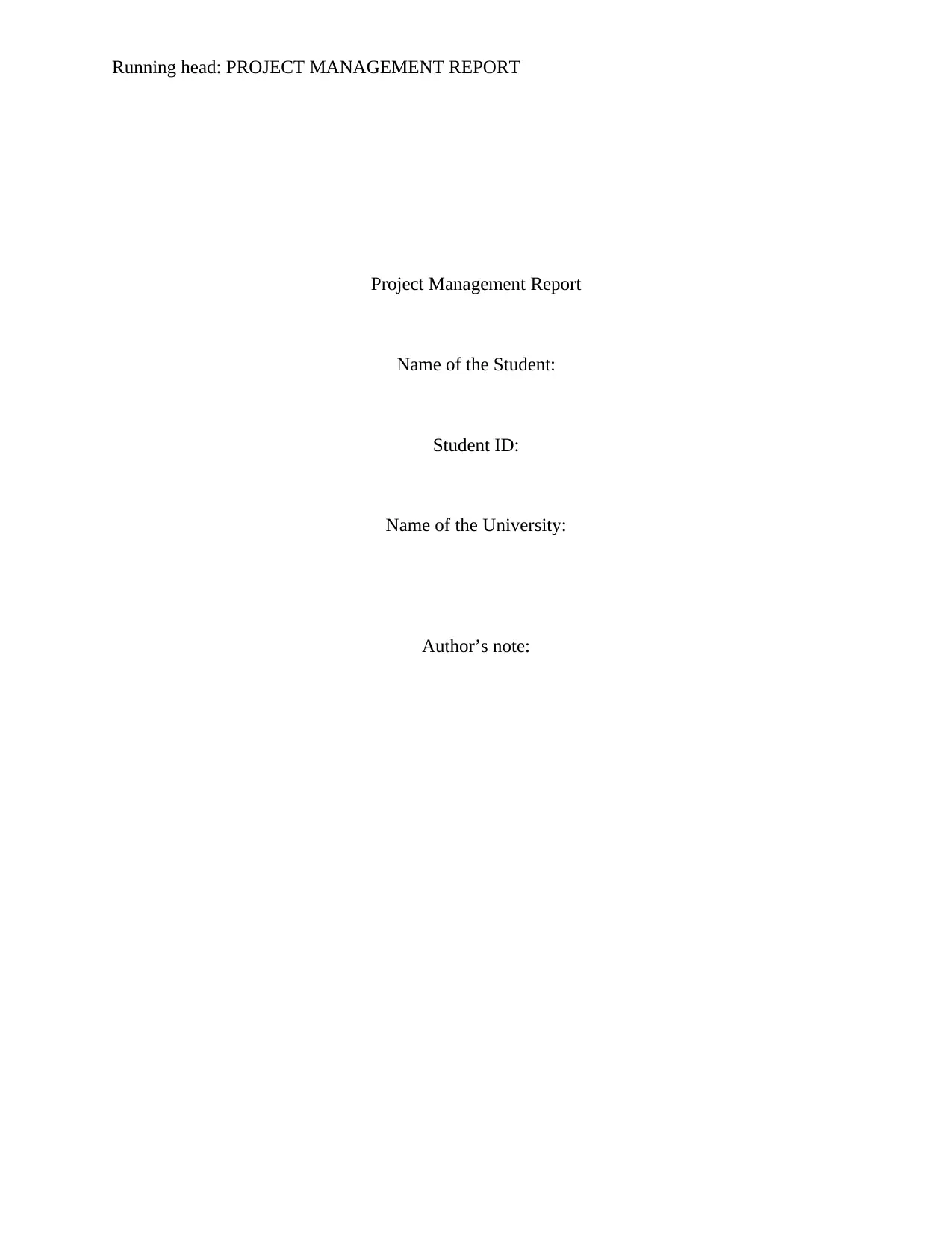
Running head: PROJECT MANAGEMENT REPORT
Project Management Report
Name of the Student:
Student ID:
Name of the University:
Author’s note:
Project Management Report
Name of the Student:
Student ID:
Name of the University:
Author’s note:
Secure Best Marks with AI Grader
Need help grading? Try our AI Grader for instant feedback on your assignments.
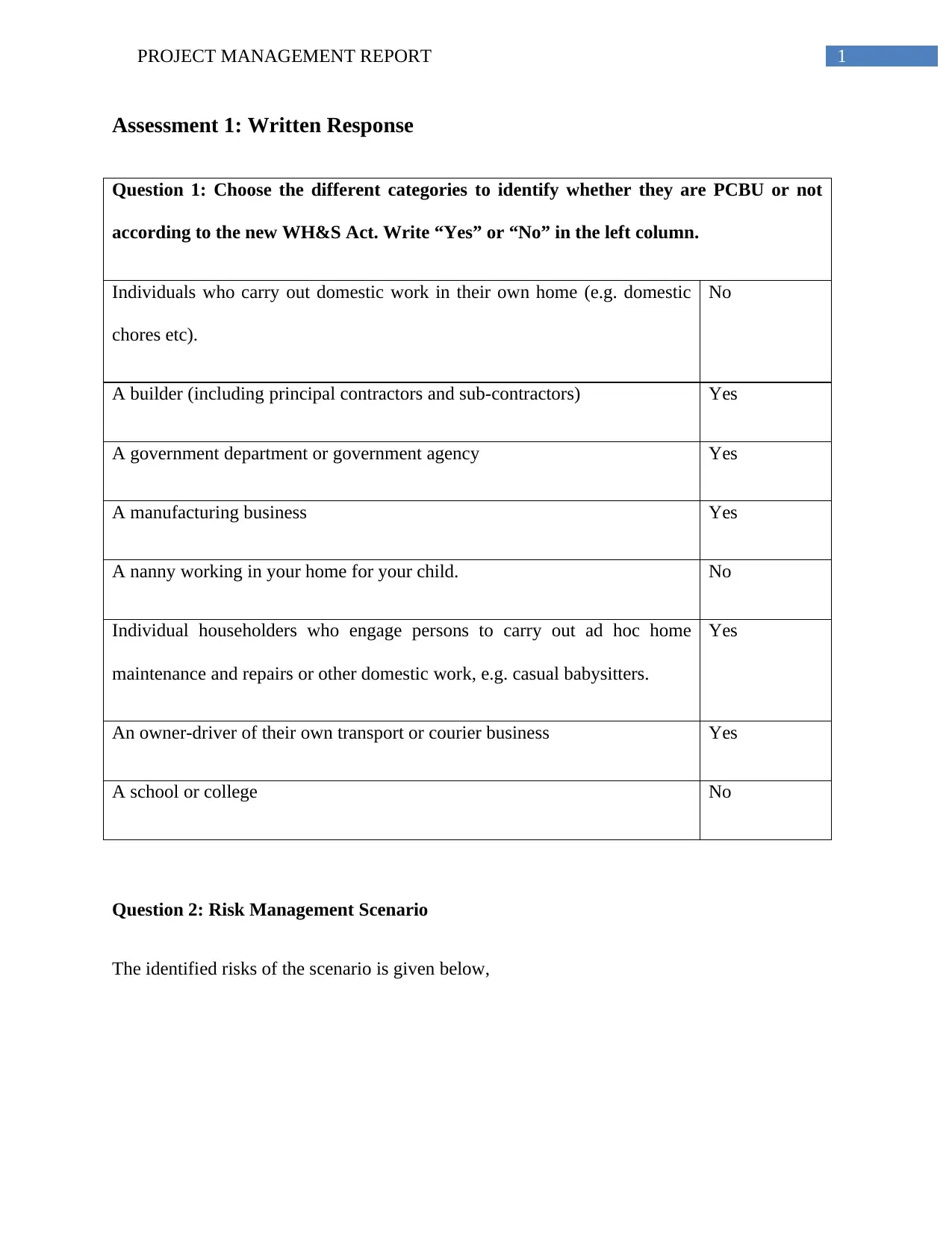
1PROJECT MANAGEMENT REPORT
Assessment 1: Written Response
Question 1: Choose the different categories to identify whether they are PCBU or not
according to the new WH&S Act. Write “Yes” or “No” in the left column.
Individuals who carry out domestic work in their own home (e.g. domestic
chores etc).
No
A builder (including principal contractors and sub-contractors) Yes
A government department or government agency Yes
A manufacturing business Yes
A nanny working in your home for your child. No
Individual householders who engage persons to carry out ad hoc home
maintenance and repairs or other domestic work, e.g. casual babysitters.
Yes
An owner-driver of their own transport or courier business Yes
A school or college No
Question 2: Risk Management Scenario
The identified risks of the scenario is given below,
Assessment 1: Written Response
Question 1: Choose the different categories to identify whether they are PCBU or not
according to the new WH&S Act. Write “Yes” or “No” in the left column.
Individuals who carry out domestic work in their own home (e.g. domestic
chores etc).
No
A builder (including principal contractors and sub-contractors) Yes
A government department or government agency Yes
A manufacturing business Yes
A nanny working in your home for your child. No
Individual householders who engage persons to carry out ad hoc home
maintenance and repairs or other domestic work, e.g. casual babysitters.
Yes
An owner-driver of their own transport or courier business Yes
A school or college No
Question 2: Risk Management Scenario
The identified risks of the scenario is given below,
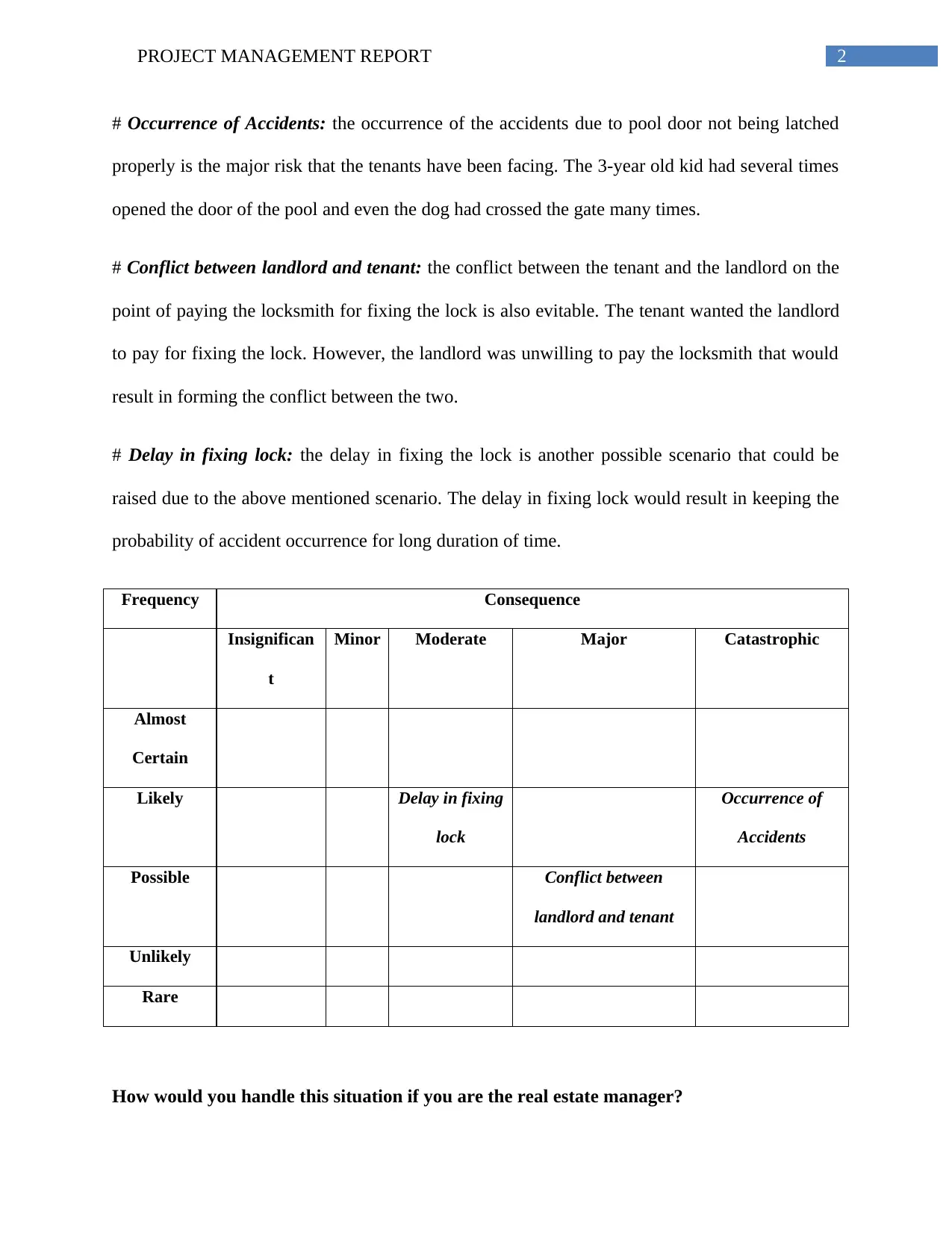
2PROJECT MANAGEMENT REPORT
# Occurrence of Accidents: the occurrence of the accidents due to pool door not being latched
properly is the major risk that the tenants have been facing. The 3-year old kid had several times
opened the door of the pool and even the dog had crossed the gate many times.
# Conflict between landlord and tenant: the conflict between the tenant and the landlord on the
point of paying the locksmith for fixing the lock is also evitable. The tenant wanted the landlord
to pay for fixing the lock. However, the landlord was unwilling to pay the locksmith that would
result in forming the conflict between the two.
# Delay in fixing lock: the delay in fixing the lock is another possible scenario that could be
raised due to the above mentioned scenario. The delay in fixing lock would result in keeping the
probability of accident occurrence for long duration of time.
Frequency Consequence
Insignifican
t
Minor Moderate Major Catastrophic
Almost
Certain
Likely Delay in fixing
lock
Occurrence of
Accidents
Possible Conflict between
landlord and tenant
Unlikely
Rare
How would you handle this situation if you are the real estate manager?
# Occurrence of Accidents: the occurrence of the accidents due to pool door not being latched
properly is the major risk that the tenants have been facing. The 3-year old kid had several times
opened the door of the pool and even the dog had crossed the gate many times.
# Conflict between landlord and tenant: the conflict between the tenant and the landlord on the
point of paying the locksmith for fixing the lock is also evitable. The tenant wanted the landlord
to pay for fixing the lock. However, the landlord was unwilling to pay the locksmith that would
result in forming the conflict between the two.
# Delay in fixing lock: the delay in fixing the lock is another possible scenario that could be
raised due to the above mentioned scenario. The delay in fixing lock would result in keeping the
probability of accident occurrence for long duration of time.
Frequency Consequence
Insignifican
t
Minor Moderate Major Catastrophic
Almost
Certain
Likely Delay in fixing
lock
Occurrence of
Accidents
Possible Conflict between
landlord and tenant
Unlikely
Rare
How would you handle this situation if you are the real estate manager?
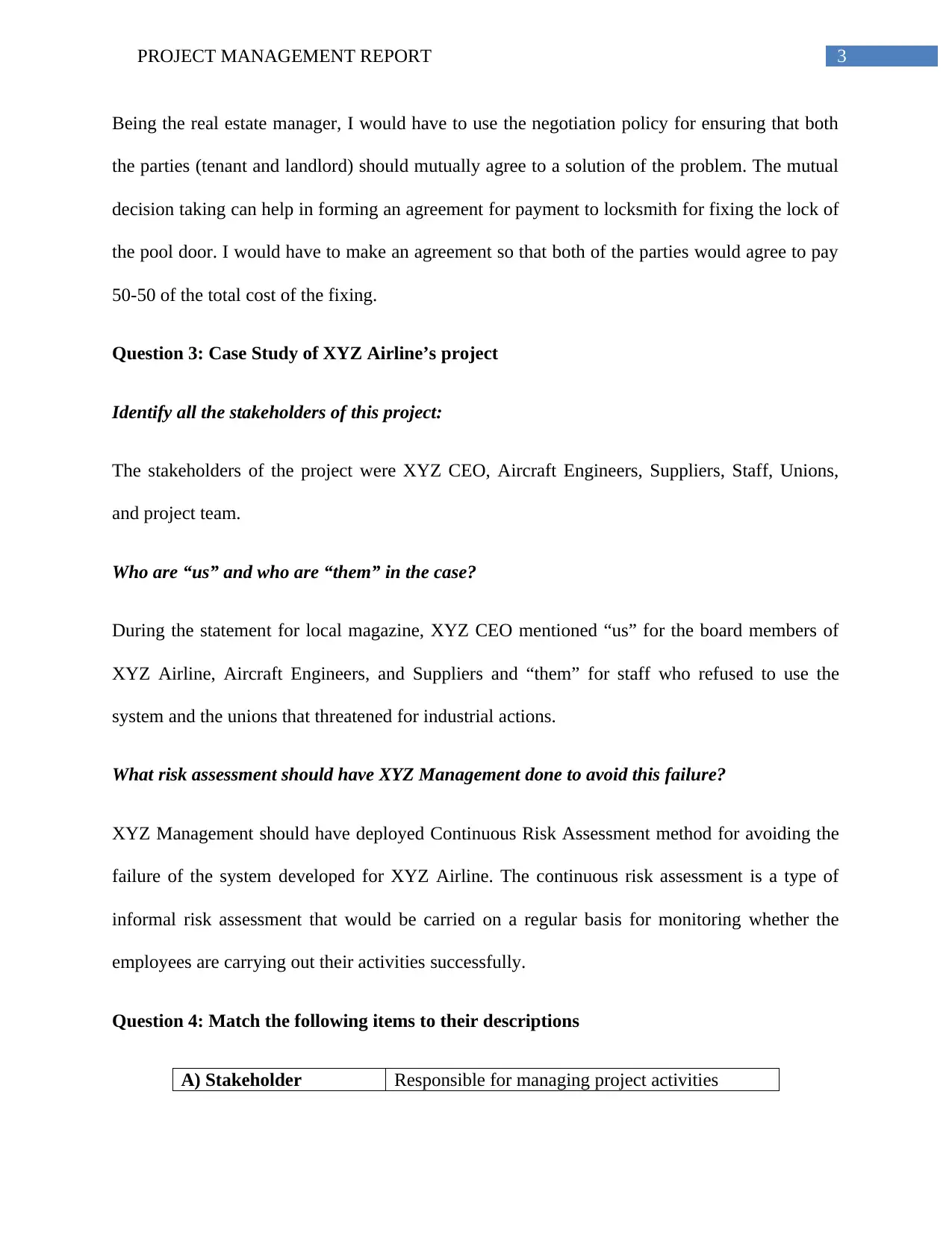
3PROJECT MANAGEMENT REPORT
Being the real estate manager, I would have to use the negotiation policy for ensuring that both
the parties (tenant and landlord) should mutually agree to a solution of the problem. The mutual
decision taking can help in forming an agreement for payment to locksmith for fixing the lock of
the pool door. I would have to make an agreement so that both of the parties would agree to pay
50-50 of the total cost of the fixing.
Question 3: Case Study of XYZ Airline’s project
Identify all the stakeholders of this project:
The stakeholders of the project were XYZ CEO, Aircraft Engineers, Suppliers, Staff, Unions,
and project team.
Who are “us” and who are “them” in the case?
During the statement for local magazine, XYZ CEO mentioned “us” for the board members of
XYZ Airline, Aircraft Engineers, and Suppliers and “them” for staff who refused to use the
system and the unions that threatened for industrial actions.
What risk assessment should have XYZ Management done to avoid this failure?
XYZ Management should have deployed Continuous Risk Assessment method for avoiding the
failure of the system developed for XYZ Airline. The continuous risk assessment is a type of
informal risk assessment that would be carried on a regular basis for monitoring whether the
employees are carrying out their activities successfully.
Question 4: Match the following items to their descriptions
A) Stakeholder Responsible for managing project activities
Being the real estate manager, I would have to use the negotiation policy for ensuring that both
the parties (tenant and landlord) should mutually agree to a solution of the problem. The mutual
decision taking can help in forming an agreement for payment to locksmith for fixing the lock of
the pool door. I would have to make an agreement so that both of the parties would agree to pay
50-50 of the total cost of the fixing.
Question 3: Case Study of XYZ Airline’s project
Identify all the stakeholders of this project:
The stakeholders of the project were XYZ CEO, Aircraft Engineers, Suppliers, Staff, Unions,
and project team.
Who are “us” and who are “them” in the case?
During the statement for local magazine, XYZ CEO mentioned “us” for the board members of
XYZ Airline, Aircraft Engineers, and Suppliers and “them” for staff who refused to use the
system and the unions that threatened for industrial actions.
What risk assessment should have XYZ Management done to avoid this failure?
XYZ Management should have deployed Continuous Risk Assessment method for avoiding the
failure of the system developed for XYZ Airline. The continuous risk assessment is a type of
informal risk assessment that would be carried on a regular basis for monitoring whether the
employees are carrying out their activities successfully.
Question 4: Match the following items to their descriptions
A) Stakeholder Responsible for managing project activities
Secure Best Marks with AI Grader
Need help grading? Try our AI Grader for instant feedback on your assignments.
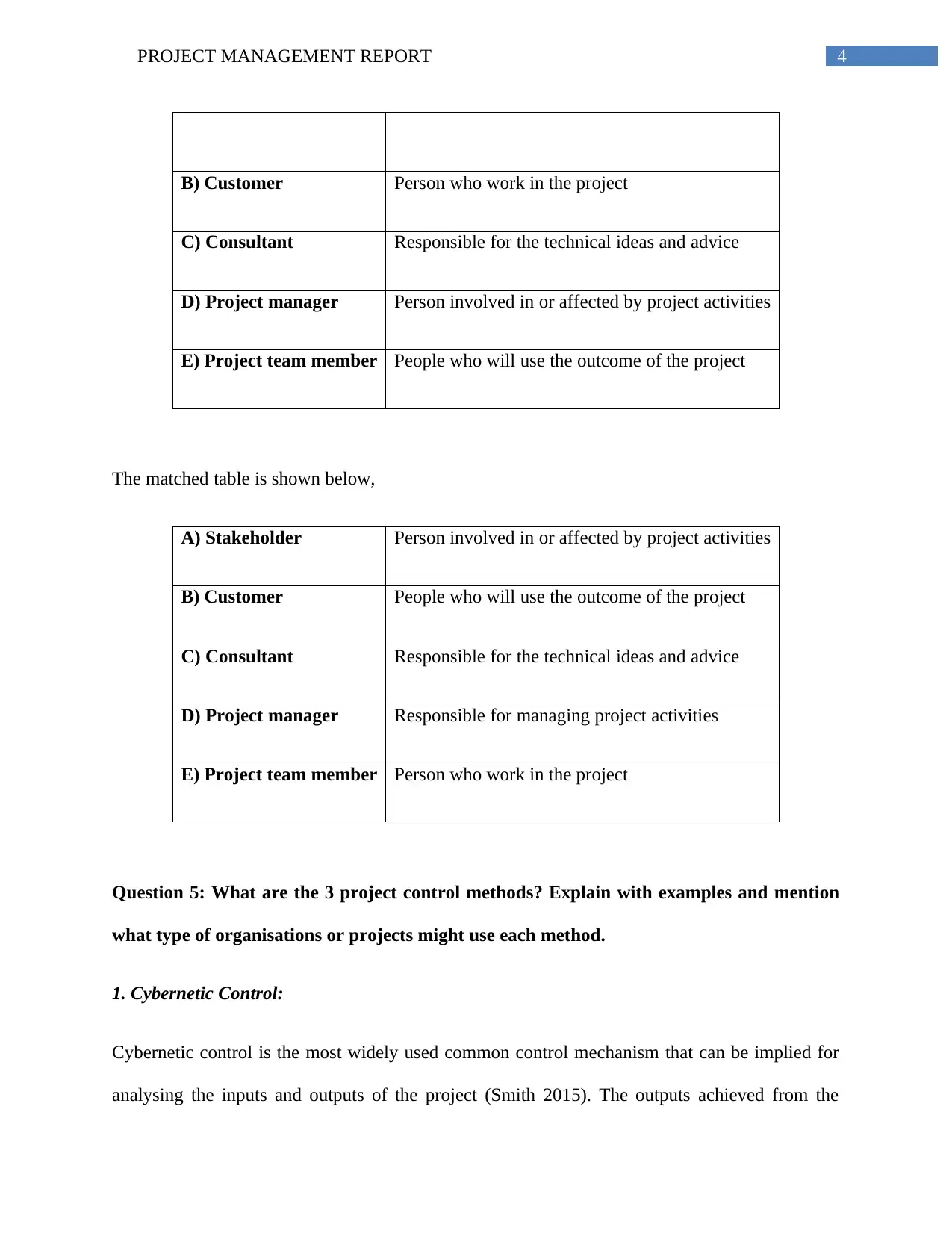
4PROJECT MANAGEMENT REPORT
B) Customer Person who work in the project
C) Consultant Responsible for the technical ideas and advice
D) Project manager Person involved in or affected by project activities
E) Project team member People who will use the outcome of the project
The matched table is shown below,
A) Stakeholder Person involved in or affected by project activities
B) Customer People who will use the outcome of the project
C) Consultant Responsible for the technical ideas and advice
D) Project manager Responsible for managing project activities
E) Project team member Person who work in the project
Question 5: What are the 3 project control methods? Explain with examples and mention
what type of organisations or projects might use each method.
1. Cybernetic Control:
Cybernetic control is the most widely used common control mechanism that can be implied for
analysing the inputs and outputs of the project (Smith 2015). The outputs achieved from the
B) Customer Person who work in the project
C) Consultant Responsible for the technical ideas and advice
D) Project manager Person involved in or affected by project activities
E) Project team member People who will use the outcome of the project
The matched table is shown below,
A) Stakeholder Person involved in or affected by project activities
B) Customer People who will use the outcome of the project
C) Consultant Responsible for the technical ideas and advice
D) Project manager Responsible for managing project activities
E) Project team member Person who work in the project
Question 5: What are the 3 project control methods? Explain with examples and mention
what type of organisations or projects might use each method.
1. Cybernetic Control:
Cybernetic control is the most widely used common control mechanism that can be implied for
analysing the inputs and outputs of the project (Smith 2015). The outputs achieved from the
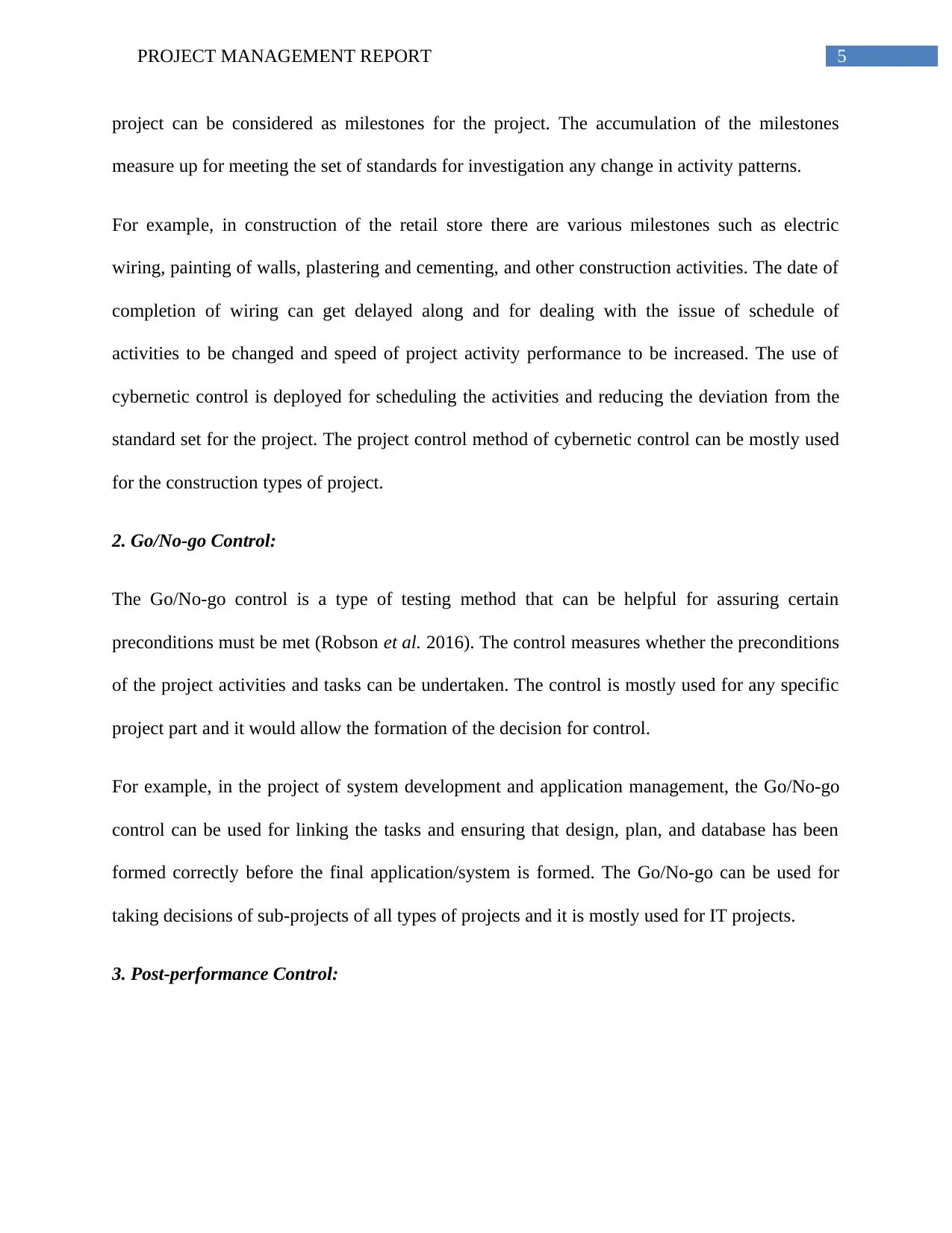
5PROJECT MANAGEMENT REPORT
project can be considered as milestones for the project. The accumulation of the milestones
measure up for meeting the set of standards for investigation any change in activity patterns.
For example, in construction of the retail store there are various milestones such as electric
wiring, painting of walls, plastering and cementing, and other construction activities. The date of
completion of wiring can get delayed along and for dealing with the issue of schedule of
activities to be changed and speed of project activity performance to be increased. The use of
cybernetic control is deployed for scheduling the activities and reducing the deviation from the
standard set for the project. The project control method of cybernetic control can be mostly used
for the construction types of project.
2. Go/No-go Control:
The Go/No-go control is a type of testing method that can be helpful for assuring certain
preconditions must be met (Robson et al. 2016). The control measures whether the preconditions
of the project activities and tasks can be undertaken. The control is mostly used for any specific
project part and it would allow the formation of the decision for control.
For example, in the project of system development and application management, the Go/No-go
control can be used for linking the tasks and ensuring that design, plan, and database has been
formed correctly before the final application/system is formed. The Go/No-go can be used for
taking decisions of sub-projects of all types of projects and it is mostly used for IT projects.
3. Post-performance Control:
project can be considered as milestones for the project. The accumulation of the milestones
measure up for meeting the set of standards for investigation any change in activity patterns.
For example, in construction of the retail store there are various milestones such as electric
wiring, painting of walls, plastering and cementing, and other construction activities. The date of
completion of wiring can get delayed along and for dealing with the issue of schedule of
activities to be changed and speed of project activity performance to be increased. The use of
cybernetic control is deployed for scheduling the activities and reducing the deviation from the
standard set for the project. The project control method of cybernetic control can be mostly used
for the construction types of project.
2. Go/No-go Control:
The Go/No-go control is a type of testing method that can be helpful for assuring certain
preconditions must be met (Robson et al. 2016). The control measures whether the preconditions
of the project activities and tasks can be undertaken. The control is mostly used for any specific
project part and it would allow the formation of the decision for control.
For example, in the project of system development and application management, the Go/No-go
control can be used for linking the tasks and ensuring that design, plan, and database has been
formed correctly before the final application/system is formed. The Go/No-go can be used for
taking decisions of sub-projects of all types of projects and it is mostly used for IT projects.
3. Post-performance Control:
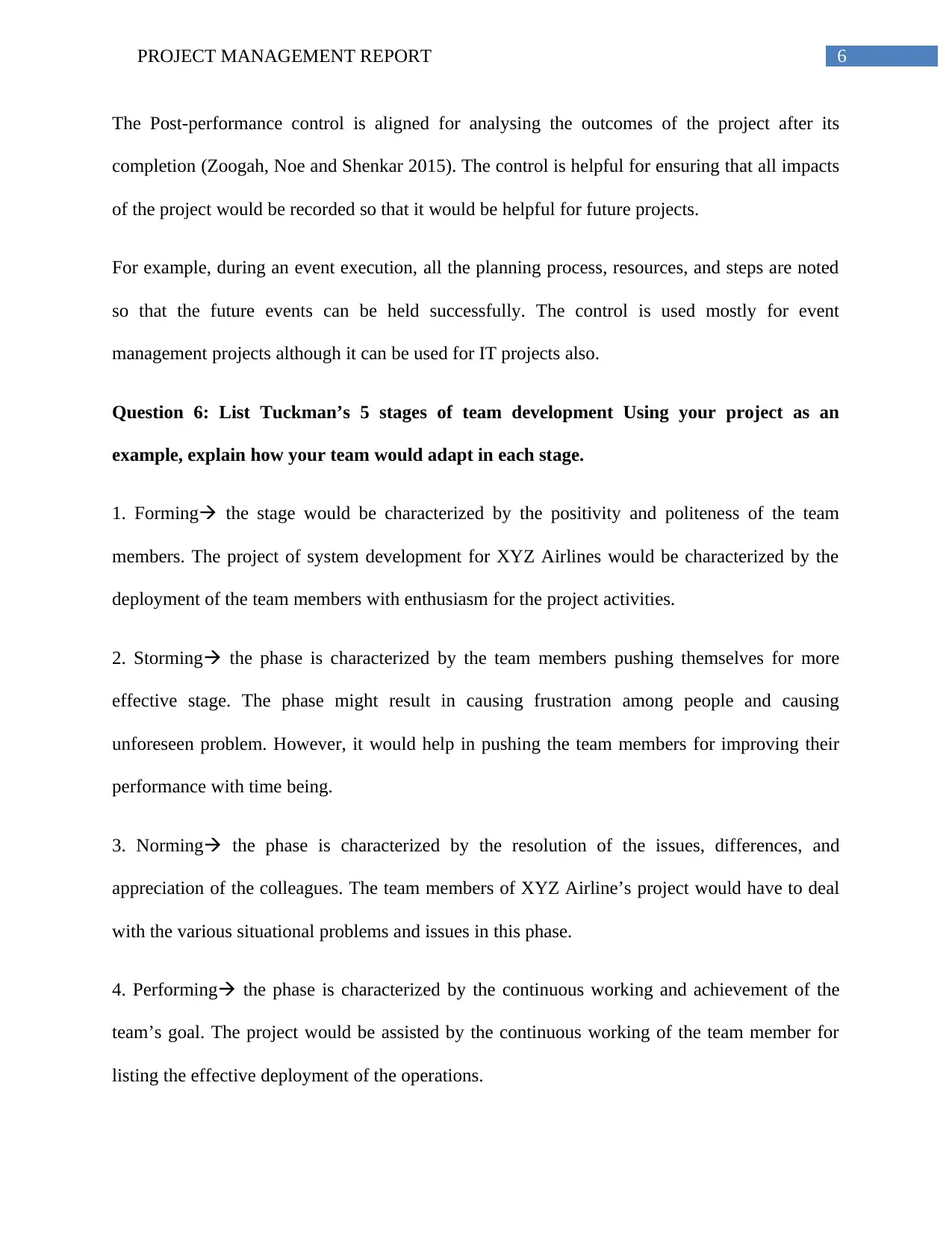
6PROJECT MANAGEMENT REPORT
The Post-performance control is aligned for analysing the outcomes of the project after its
completion (Zoogah, Noe and Shenkar 2015). The control is helpful for ensuring that all impacts
of the project would be recorded so that it would be helpful for future projects.
For example, during an event execution, all the planning process, resources, and steps are noted
so that the future events can be held successfully. The control is used mostly for event
management projects although it can be used for IT projects also.
Question 6: List Tuckman’s 5 stages of team development Using your project as an
example, explain how your team would adapt in each stage.
1. Forming the stage would be characterized by the positivity and politeness of the team
members. The project of system development for XYZ Airlines would be characterized by the
deployment of the team members with enthusiasm for the project activities.
2. Storming the phase is characterized by the team members pushing themselves for more
effective stage. The phase might result in causing frustration among people and causing
unforeseen problem. However, it would help in pushing the team members for improving their
performance with time being.
3. Norming the phase is characterized by the resolution of the issues, differences, and
appreciation of the colleagues. The team members of XYZ Airline’s project would have to deal
with the various situational problems and issues in this phase.
4. Performing the phase is characterized by the continuous working and achievement of the
team’s goal. The project would be assisted by the continuous working of the team member for
listing the effective deployment of the operations.
The Post-performance control is aligned for analysing the outcomes of the project after its
completion (Zoogah, Noe and Shenkar 2015). The control is helpful for ensuring that all impacts
of the project would be recorded so that it would be helpful for future projects.
For example, during an event execution, all the planning process, resources, and steps are noted
so that the future events can be held successfully. The control is used mostly for event
management projects although it can be used for IT projects also.
Question 6: List Tuckman’s 5 stages of team development Using your project as an
example, explain how your team would adapt in each stage.
1. Forming the stage would be characterized by the positivity and politeness of the team
members. The project of system development for XYZ Airlines would be characterized by the
deployment of the team members with enthusiasm for the project activities.
2. Storming the phase is characterized by the team members pushing themselves for more
effective stage. The phase might result in causing frustration among people and causing
unforeseen problem. However, it would help in pushing the team members for improving their
performance with time being.
3. Norming the phase is characterized by the resolution of the issues, differences, and
appreciation of the colleagues. The team members of XYZ Airline’s project would have to deal
with the various situational problems and issues in this phase.
4. Performing the phase is characterized by the continuous working and achievement of the
team’s goal. The project would be assisted by the continuous working of the team member for
listing the effective deployment of the operations.
Paraphrase This Document
Need a fresh take? Get an instant paraphrase of this document with our AI Paraphraser
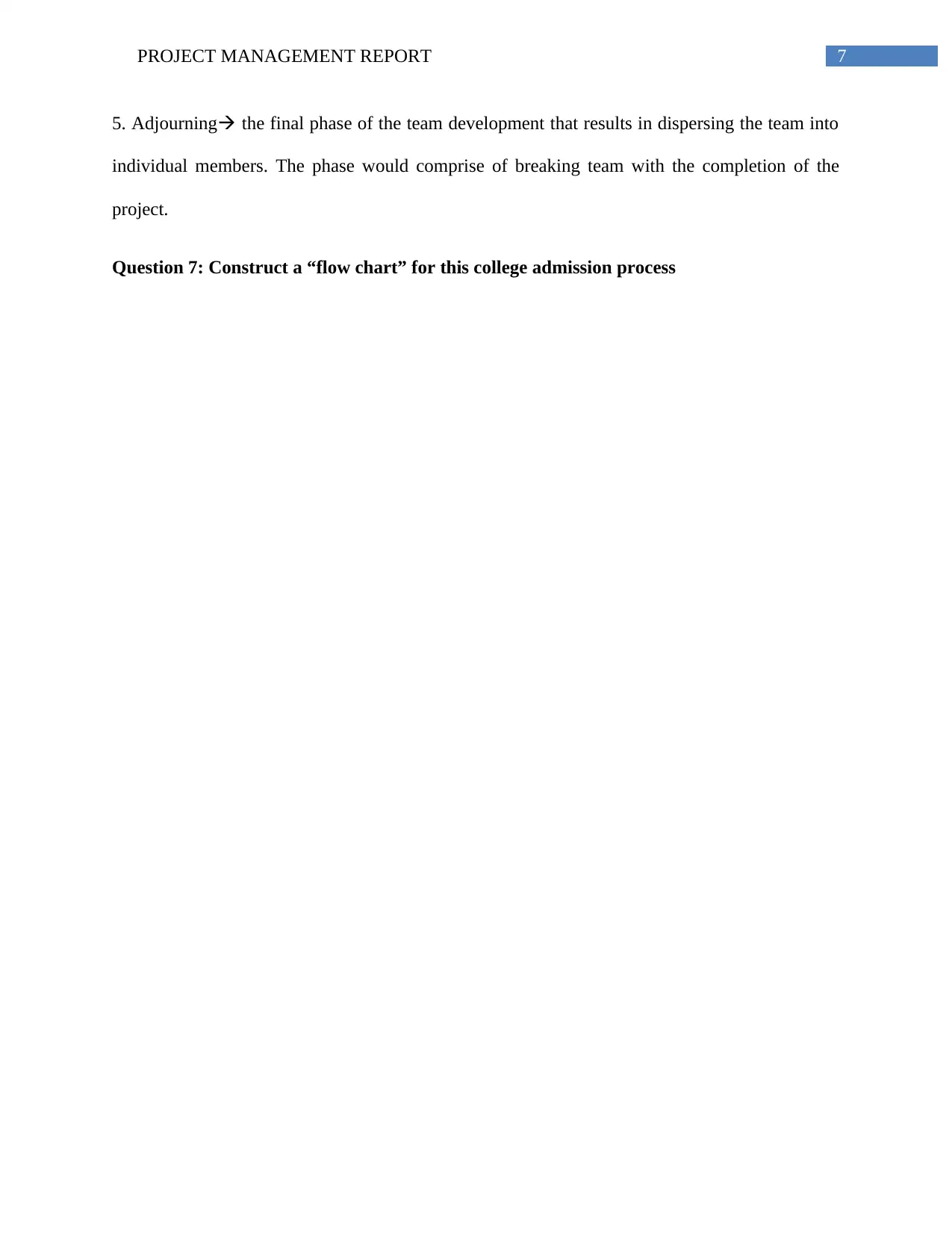
7PROJECT MANAGEMENT REPORT
5. Adjourning the final phase of the team development that results in dispersing the team into
individual members. The phase would comprise of breaking team with the completion of the
project.
Question 7: Construct a “flow chart” for this college admission process
5. Adjourning the final phase of the team development that results in dispersing the team into
individual members. The phase would comprise of breaking team with the completion of the
project.
Question 7: Construct a “flow chart” for this college admission process
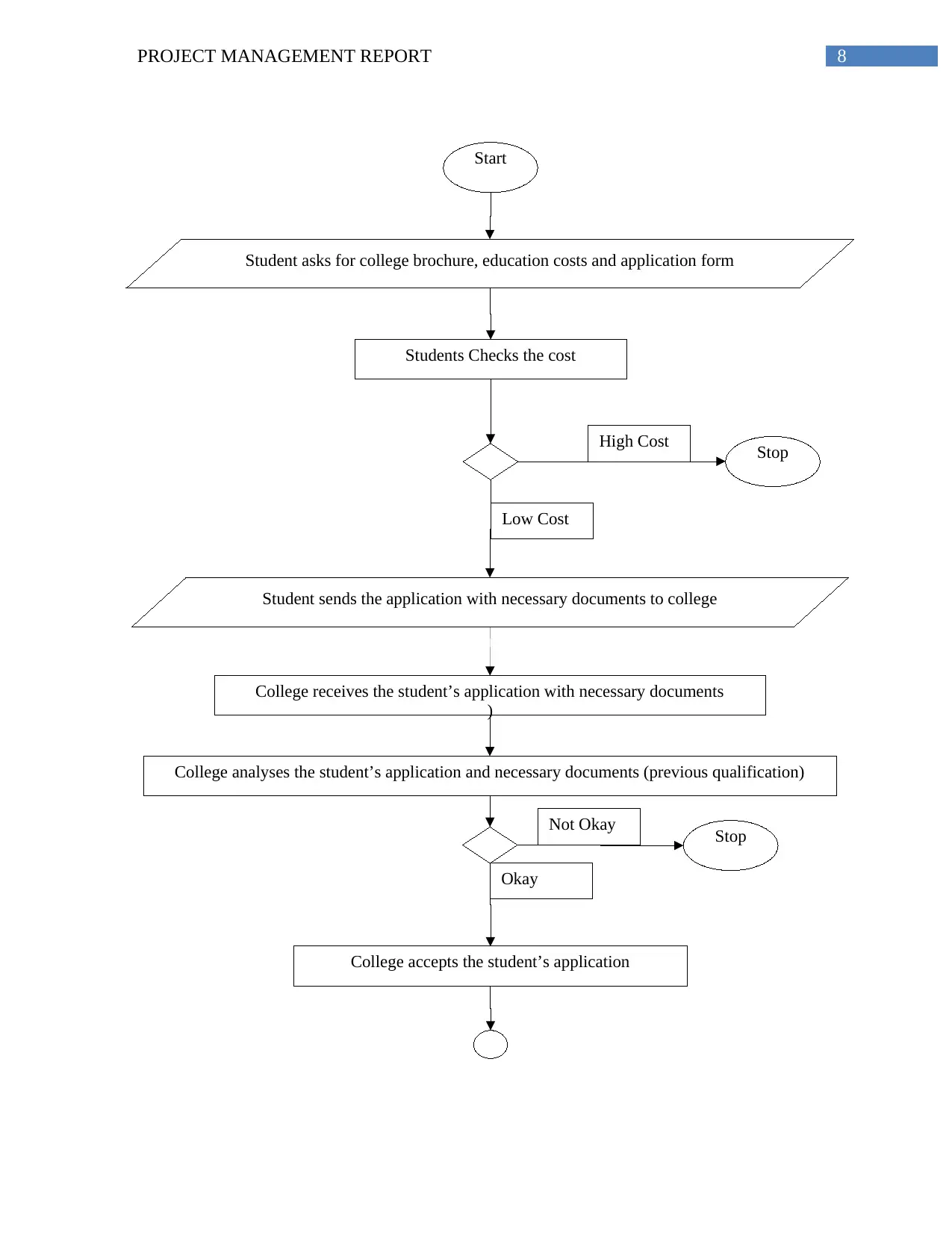
8PROJECT MANAGEMENT REPORT
Start
Student asks for college brochure, education costs and application form
Students Checks the cost
Stop
Student sends the application with necessary documents to college
College analyses the student’s application and necessary documents (previous qualification)
Stop
College accepts the student’s application
College receives the student’s application with necessary documents
)
High Cost
Low Cost
Not Okay
Okay
Start
Student asks for college brochure, education costs and application form
Students Checks the cost
Stop
Student sends the application with necessary documents to college
College analyses the student’s application and necessary documents (previous qualification)
Stop
College accepts the student’s application
College receives the student’s application with necessary documents
)
High Cost
Low Cost
Not Okay
Okay
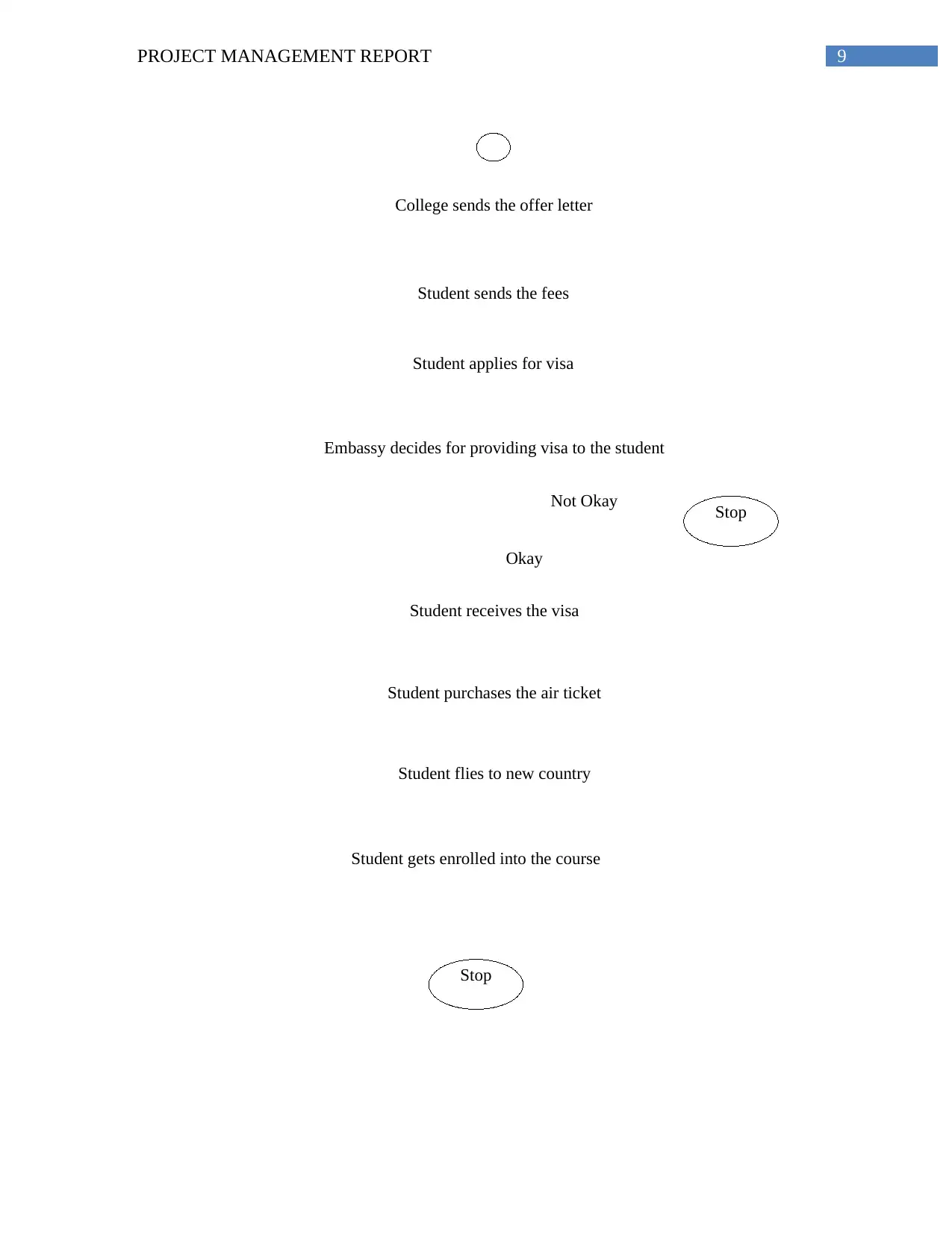
9PROJECT MANAGEMENT REPORT
College sends the offer letter
Student sends the fees
Student applies for visa
Embassy decides for providing visa to the student
Student receives the visa
Stop
Stop
Student purchases the air ticket
Student flies to new country
Student gets enrolled into the course
Not Okay
Okay
College sends the offer letter
Student sends the fees
Student applies for visa
Embassy decides for providing visa to the student
Student receives the visa
Stop
Stop
Student purchases the air ticket
Student flies to new country
Student gets enrolled into the course
Not Okay
Okay
Secure Best Marks with AI Grader
Need help grading? Try our AI Grader for instant feedback on your assignments.
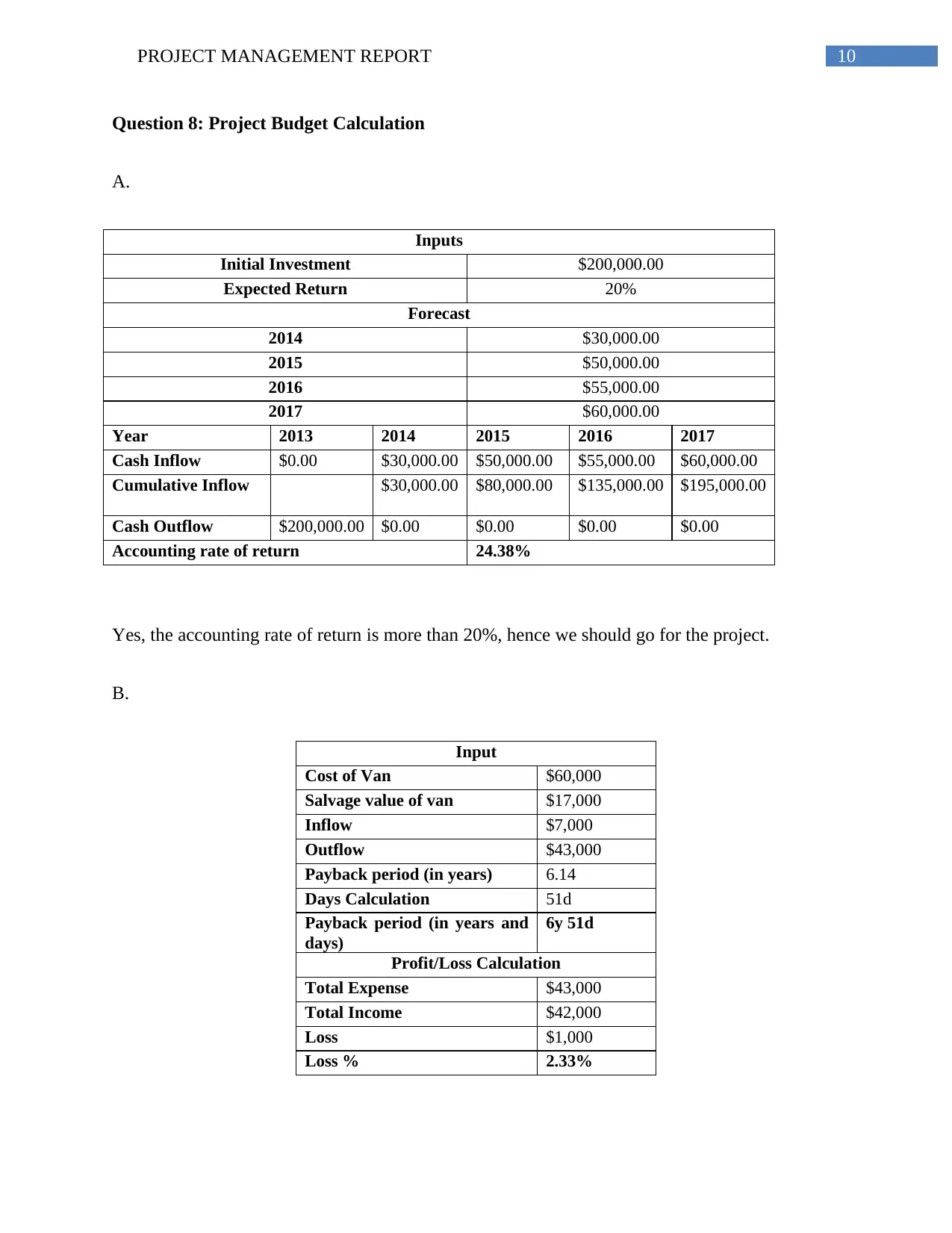
10PROJECT MANAGEMENT REPORT
Question 8: Project Budget Calculation
A.
Inputs
Initial Investment $200,000.00
Expected Return 20%
Forecast
2014 $30,000.00
2015 $50,000.00
2016 $55,000.00
2017 $60,000.00
Year 2013 2014 2015 2016 2017
Cash Inflow $0.00 $30,000.00 $50,000.00 $55,000.00 $60,000.00
Cumulative Inflow $30,000.00 $80,000.00 $135,000.00 $195,000.00
Cash Outflow $200,000.00 $0.00 $0.00 $0.00 $0.00
Accounting rate of return 24.38%
Yes, the accounting rate of return is more than 20%, hence we should go for the project.
B.
Input
Cost of Van $60,000
Salvage value of van $17,000
Inflow $7,000
Outflow $43,000
Payback period (in years) 6.14
Days Calculation 51d
Payback period (in years and
days)
6y 51d
Profit/Loss Calculation
Total Expense $43,000
Total Income $42,000
Loss $1,000
Loss % 2.33%
Question 8: Project Budget Calculation
A.
Inputs
Initial Investment $200,000.00
Expected Return 20%
Forecast
2014 $30,000.00
2015 $50,000.00
2016 $55,000.00
2017 $60,000.00
Year 2013 2014 2015 2016 2017
Cash Inflow $0.00 $30,000.00 $50,000.00 $55,000.00 $60,000.00
Cumulative Inflow $30,000.00 $80,000.00 $135,000.00 $195,000.00
Cash Outflow $200,000.00 $0.00 $0.00 $0.00 $0.00
Accounting rate of return 24.38%
Yes, the accounting rate of return is more than 20%, hence we should go for the project.
B.
Input
Cost of Van $60,000
Salvage value of van $17,000
Inflow $7,000
Outflow $43,000
Payback period (in years) 6.14
Days Calculation 51d
Payback period (in years and
days)
6y 51d
Profit/Loss Calculation
Total Expense $43,000
Total Income $42,000
Loss $1,000
Loss % 2.33%
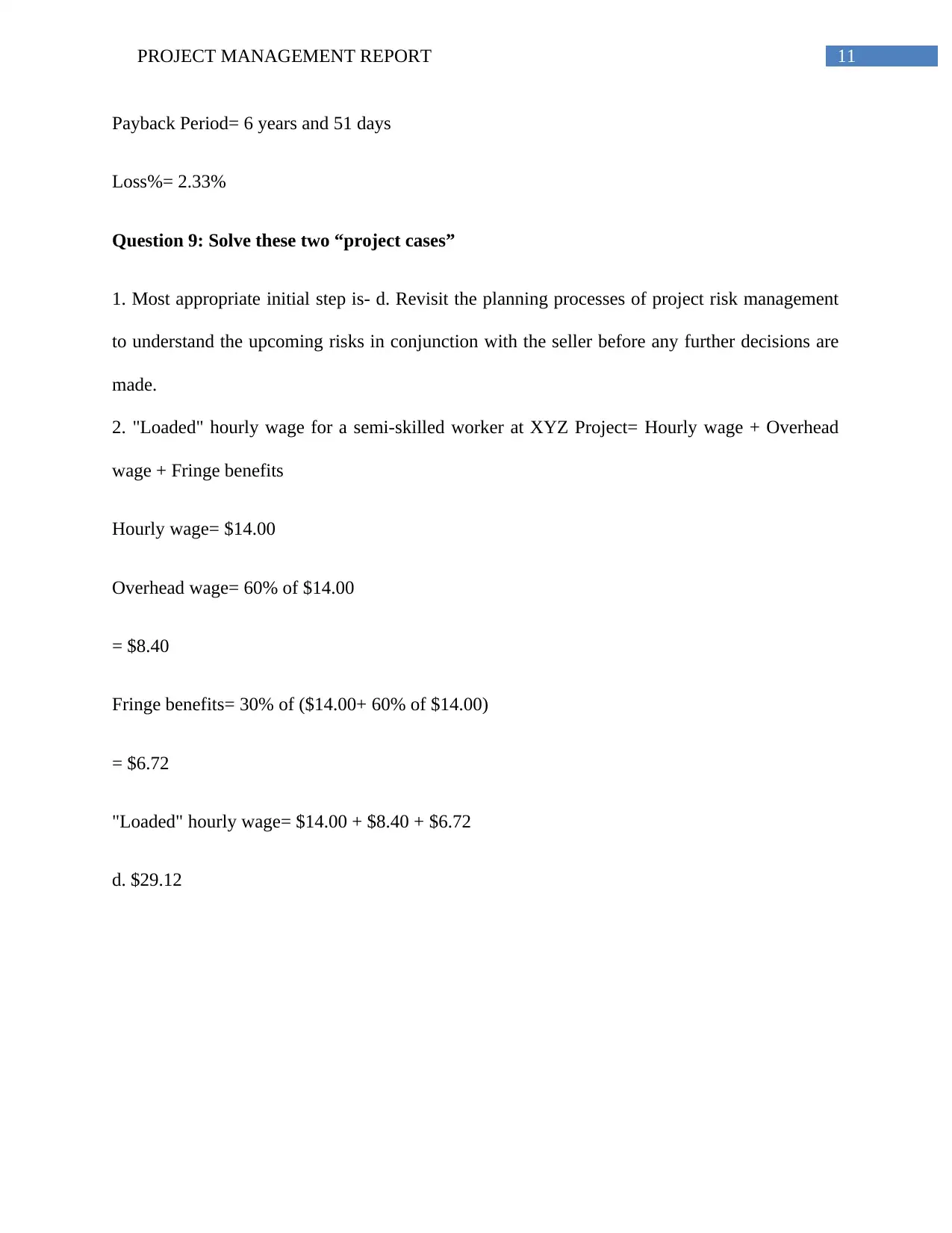
11PROJECT MANAGEMENT REPORT
Payback Period= 6 years and 51 days
Loss%= 2.33%
Question 9: Solve these two “project cases”
1. Most appropriate initial step is- d. Revisit the planning processes of project risk management
to understand the upcoming risks in conjunction with the seller before any further decisions are
made.
2. "Loaded" hourly wage for a semi-skilled worker at XYZ Project= Hourly wage + Overhead
wage + Fringe benefits
Hourly wage= $14.00
Overhead wage= 60% of $14.00
= $8.40
Fringe benefits= 30% of ($14.00+ 60% of $14.00)
= $6.72
"Loaded" hourly wage= $14.00 + $8.40 + $6.72
d. $29.12
Payback Period= 6 years and 51 days
Loss%= 2.33%
Question 9: Solve these two “project cases”
1. Most appropriate initial step is- d. Revisit the planning processes of project risk management
to understand the upcoming risks in conjunction with the seller before any further decisions are
made.
2. "Loaded" hourly wage for a semi-skilled worker at XYZ Project= Hourly wage + Overhead
wage + Fringe benefits
Hourly wage= $14.00
Overhead wage= 60% of $14.00
= $8.40
Fringe benefits= 30% of ($14.00+ 60% of $14.00)
= $6.72
"Loaded" hourly wage= $14.00 + $8.40 + $6.72
d. $29.12
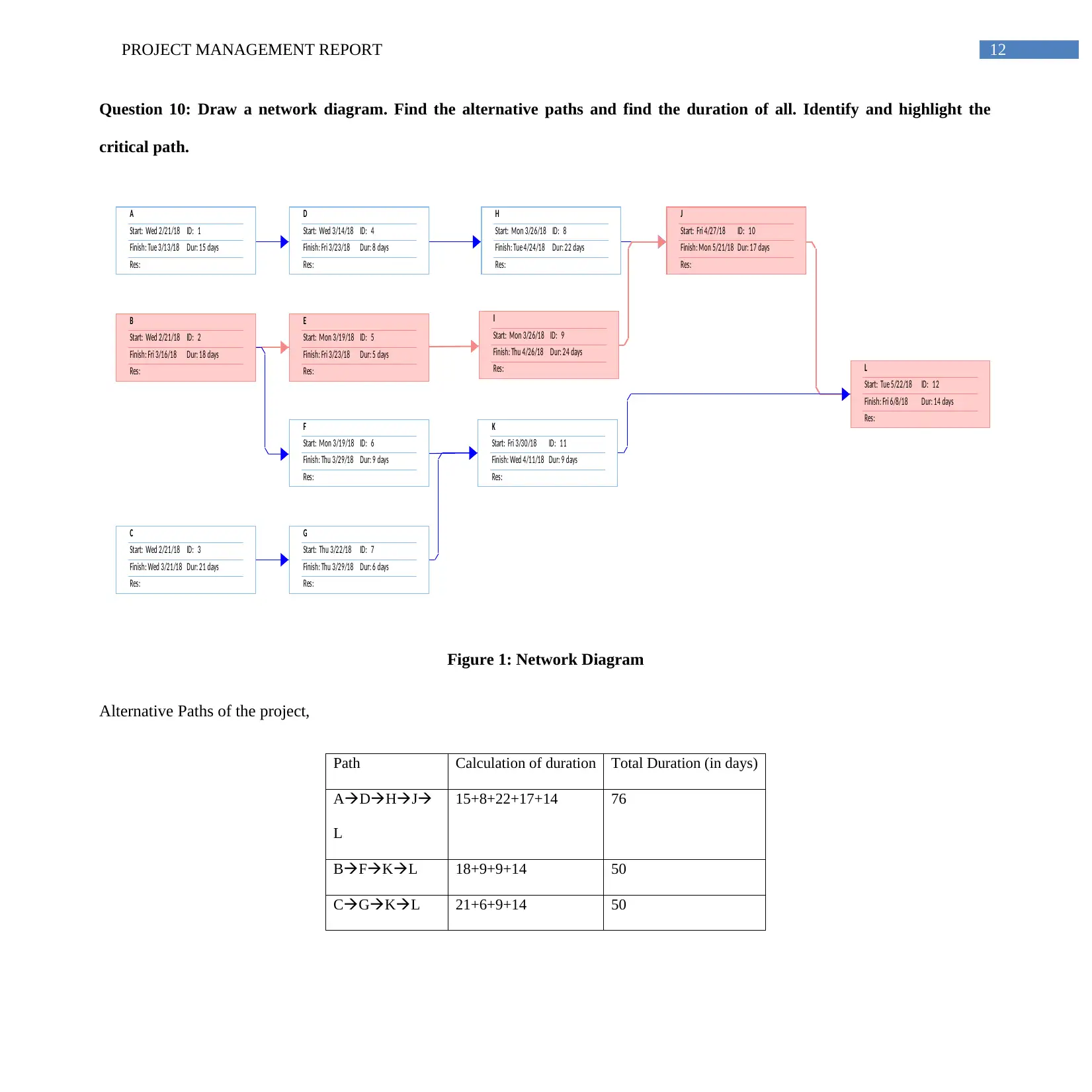
12PROJECT MANAGEMENT REPORT
Question 10: Draw a network diagram. Find the alternative paths and find the duration of all. Identify and highlight the
critical path.
B
Start: Wed 2/21/18 ID: 2
Finish: Fri 3/16/18 Dur: 18 days
Res:
C
Start: Wed 2/21/18 ID: 3
Finish: Wed 3/21/18 Dur: 21 days
Res:
D
Start: Wed 3/14/18 ID: 4
Finish: Fri 3/23/18 Dur: 8 days
Res:
E
Start: Mon 3/19/18 ID: 5
Finish: Fri 3/23/18 Dur: 5 days
Res:
F
Start: Mon 3/19/18 ID: 6
Finish: Thu 3/29/18 Dur: 9 days
Res:
G
Start: Thu 3/22/18 ID: 7
Finish: Thu 3/29/18 Dur: 6 days
Res:
A
Start: Wed 2/21/18 ID: 1
Finish: Tue 3/13/18 Dur: 15 days
Res:
H
Start: Mon 3/26/18 ID: 8
Finish: Tue 4/24/18 Dur: 22 days
Res:
I
Start: Mon 3/26/18 ID: 9
Finish: Thu 4/26/18 Dur: 24 days
Res:
K
Start: Fri 3/30/18 ID: 11
Finish: Wed 4/11/18 Dur: 9 days
Res:
J
Start: Fri 4/27/18 ID: 10
Finish: Mon 5/21/18 Dur: 17 days
Res:
L
Start: Tue 5/22/18 ID: 12
Finish: Fri 6/8/18 Dur: 14 days
Res:
Figure 1: Network Diagram
Alternative Paths of the project,
Path Calculation of duration Total Duration (in days)
ADHJ
L
15+8+22+17+14 76
BFKL 18+9+9+14 50
CGKL 21+6+9+14 50
Question 10: Draw a network diagram. Find the alternative paths and find the duration of all. Identify and highlight the
critical path.
B
Start: Wed 2/21/18 ID: 2
Finish: Fri 3/16/18 Dur: 18 days
Res:
C
Start: Wed 2/21/18 ID: 3
Finish: Wed 3/21/18 Dur: 21 days
Res:
D
Start: Wed 3/14/18 ID: 4
Finish: Fri 3/23/18 Dur: 8 days
Res:
E
Start: Mon 3/19/18 ID: 5
Finish: Fri 3/23/18 Dur: 5 days
Res:
F
Start: Mon 3/19/18 ID: 6
Finish: Thu 3/29/18 Dur: 9 days
Res:
G
Start: Thu 3/22/18 ID: 7
Finish: Thu 3/29/18 Dur: 6 days
Res:
A
Start: Wed 2/21/18 ID: 1
Finish: Tue 3/13/18 Dur: 15 days
Res:
H
Start: Mon 3/26/18 ID: 8
Finish: Tue 4/24/18 Dur: 22 days
Res:
I
Start: Mon 3/26/18 ID: 9
Finish: Thu 4/26/18 Dur: 24 days
Res:
K
Start: Fri 3/30/18 ID: 11
Finish: Wed 4/11/18 Dur: 9 days
Res:
J
Start: Fri 4/27/18 ID: 10
Finish: Mon 5/21/18 Dur: 17 days
Res:
L
Start: Tue 5/22/18 ID: 12
Finish: Fri 6/8/18 Dur: 14 days
Res:
Figure 1: Network Diagram
Alternative Paths of the project,
Path Calculation of duration Total Duration (in days)
ADHJ
L
15+8+22+17+14 76
BFKL 18+9+9+14 50
CGKL 21+6+9+14 50
Paraphrase This Document
Need a fresh take? Get an instant paraphrase of this document with our AI Paraphraser
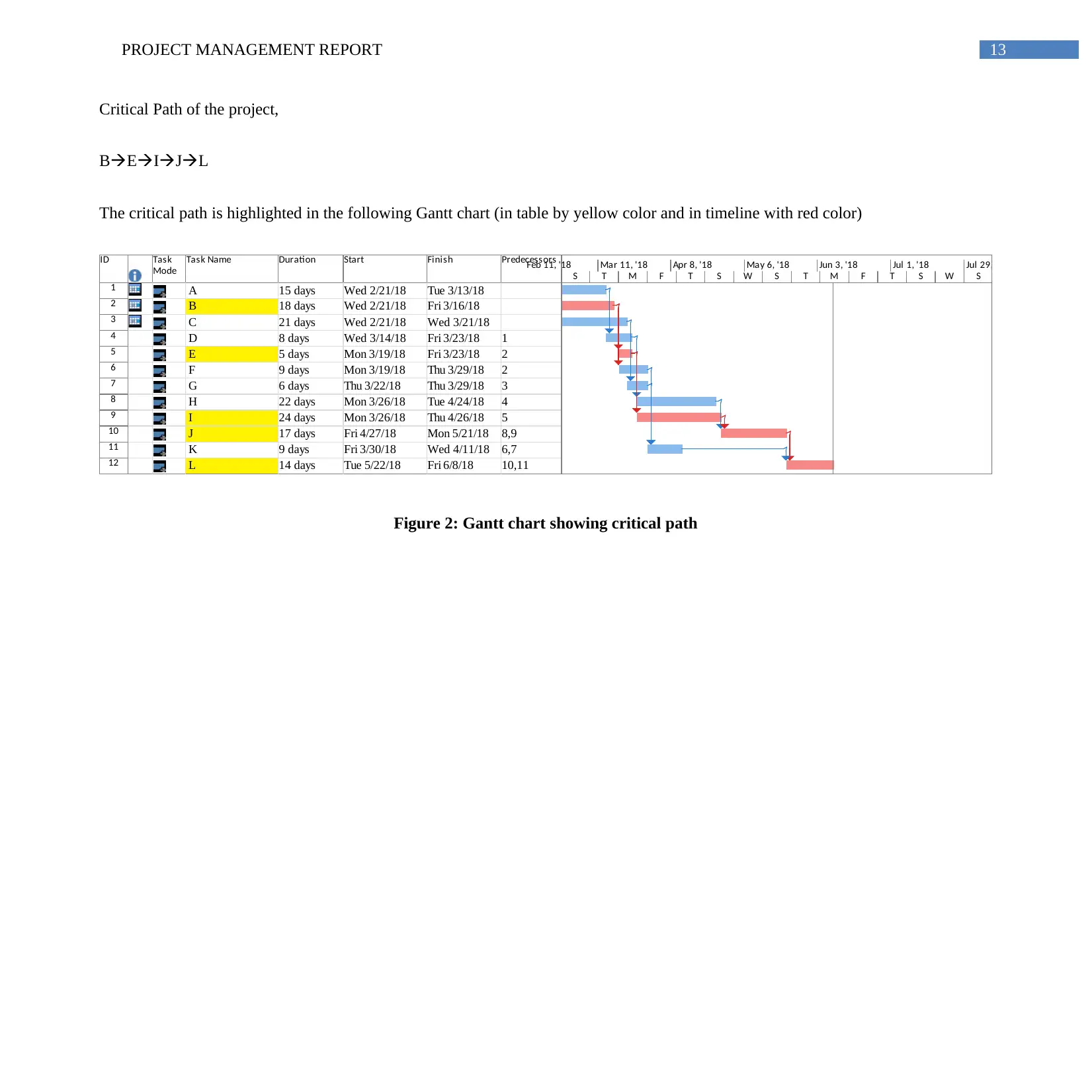
13PROJECT MANAGEMENT REPORT
Critical Path of the project,
BEIJL
The critical path is highlighted in the following Gantt chart (in table by yellow color and in timeline with red color)
ID Task
Mode
Task Name Duration Start Finish Predecessors
1 A 15 days Wed 2/21/18 Tue 3/13/18
2 B 18 days Wed 2/21/18 Fri 3/16/18
3 C 21 days Wed 2/21/18 Wed 3/21/18
4 D 8 days Wed 3/14/18 Fri 3/23/18 1
5 E 5 days Mon 3/19/18 Fri 3/23/18 2
6 F 9 days Mon 3/19/18 Thu 3/29/18 2
7 G 6 days Thu 3/22/18 Thu 3/29/18 3
8 H 22 days Mon 3/26/18 Tue 4/24/18 4
9 I 24 days Mon 3/26/18 Thu 4/26/18 5
10 J 17 days Fri 4/27/18 Mon 5/21/18 8,9
11 K 9 days Fri 3/30/18 Wed 4/11/18 6,7
12 L 14 days Tue 5/22/18 Fri 6/8/18 10,11
S T M F T S W S T M F T S W S
Feb 11, '18 Mar 11, '18 Apr 8, '18 May 6, '18 Jun 3, '18 Jul 1, '18 Jul 29, '18
Figure 2: Gantt chart showing critical path
Critical Path of the project,
BEIJL
The critical path is highlighted in the following Gantt chart (in table by yellow color and in timeline with red color)
ID Task
Mode
Task Name Duration Start Finish Predecessors
1 A 15 days Wed 2/21/18 Tue 3/13/18
2 B 18 days Wed 2/21/18 Fri 3/16/18
3 C 21 days Wed 2/21/18 Wed 3/21/18
4 D 8 days Wed 3/14/18 Fri 3/23/18 1
5 E 5 days Mon 3/19/18 Fri 3/23/18 2
6 F 9 days Mon 3/19/18 Thu 3/29/18 2
7 G 6 days Thu 3/22/18 Thu 3/29/18 3
8 H 22 days Mon 3/26/18 Tue 4/24/18 4
9 I 24 days Mon 3/26/18 Thu 4/26/18 5
10 J 17 days Fri 4/27/18 Mon 5/21/18 8,9
11 K 9 days Fri 3/30/18 Wed 4/11/18 6,7
12 L 14 days Tue 5/22/18 Fri 6/8/18 10,11
S T M F T S W S T M F T S W S
Feb 11, '18 Mar 11, '18 Apr 8, '18 May 6, '18 Jun 3, '18 Jul 1, '18 Jul 29, '18
Figure 2: Gantt chart showing critical path
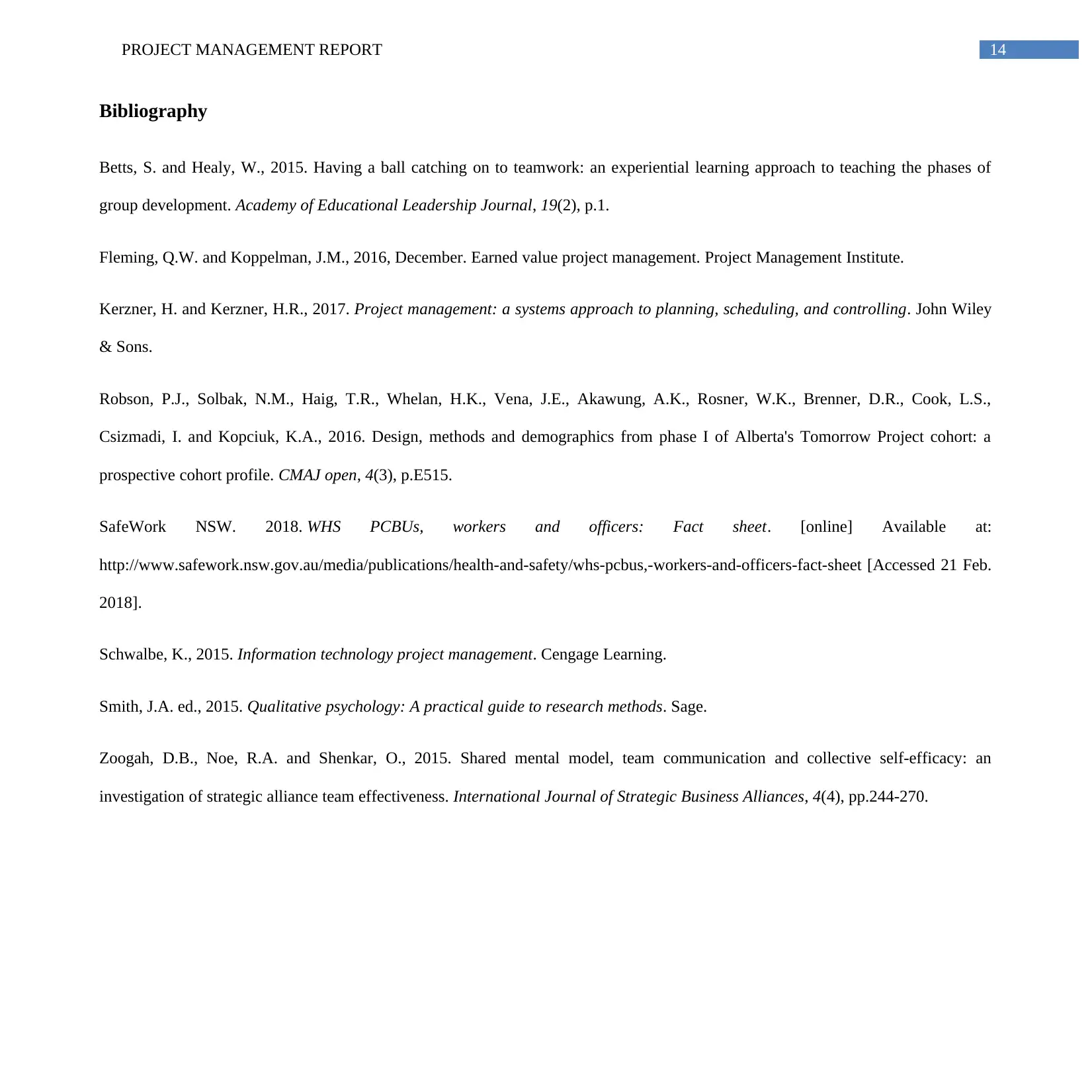
14PROJECT MANAGEMENT REPORT
Bibliography
Betts, S. and Healy, W., 2015. Having a ball catching on to teamwork: an experiential learning approach to teaching the phases of
group development. Academy of Educational Leadership Journal, 19(2), p.1.
Fleming, Q.W. and Koppelman, J.M., 2016, December. Earned value project management. Project Management Institute.
Kerzner, H. and Kerzner, H.R., 2017. Project management: a systems approach to planning, scheduling, and controlling. John Wiley
& Sons.
Robson, P.J., Solbak, N.M., Haig, T.R., Whelan, H.K., Vena, J.E., Akawung, A.K., Rosner, W.K., Brenner, D.R., Cook, L.S.,
Csizmadi, I. and Kopciuk, K.A., 2016. Design, methods and demographics from phase I of Alberta's Tomorrow Project cohort: a
prospective cohort profile. CMAJ open, 4(3), p.E515.
SafeWork NSW. 2018. WHS PCBUs, workers and officers: Fact sheet. [online] Available at:
http://www.safework.nsw.gov.au/media/publications/health-and-safety/whs-pcbus,-workers-and-officers-fact-sheet [Accessed 21 Feb.
2018].
Schwalbe, K., 2015. Information technology project management. Cengage Learning.
Smith, J.A. ed., 2015. Qualitative psychology: A practical guide to research methods. Sage.
Zoogah, D.B., Noe, R.A. and Shenkar, O., 2015. Shared mental model, team communication and collective self-efficacy: an
investigation of strategic alliance team effectiveness. International Journal of Strategic Business Alliances, 4(4), pp.244-270.
Bibliography
Betts, S. and Healy, W., 2015. Having a ball catching on to teamwork: an experiential learning approach to teaching the phases of
group development. Academy of Educational Leadership Journal, 19(2), p.1.
Fleming, Q.W. and Koppelman, J.M., 2016, December. Earned value project management. Project Management Institute.
Kerzner, H. and Kerzner, H.R., 2017. Project management: a systems approach to planning, scheduling, and controlling. John Wiley
& Sons.
Robson, P.J., Solbak, N.M., Haig, T.R., Whelan, H.K., Vena, J.E., Akawung, A.K., Rosner, W.K., Brenner, D.R., Cook, L.S.,
Csizmadi, I. and Kopciuk, K.A., 2016. Design, methods and demographics from phase I of Alberta's Tomorrow Project cohort: a
prospective cohort profile. CMAJ open, 4(3), p.E515.
SafeWork NSW. 2018. WHS PCBUs, workers and officers: Fact sheet. [online] Available at:
http://www.safework.nsw.gov.au/media/publications/health-and-safety/whs-pcbus,-workers-and-officers-fact-sheet [Accessed 21 Feb.
2018].
Schwalbe, K., 2015. Information technology project management. Cengage Learning.
Smith, J.A. ed., 2015. Qualitative psychology: A practical guide to research methods. Sage.
Zoogah, D.B., Noe, R.A. and Shenkar, O., 2015. Shared mental model, team communication and collective self-efficacy: an
investigation of strategic alliance team effectiveness. International Journal of Strategic Business Alliances, 4(4), pp.244-270.
1 out of 15
Your All-in-One AI-Powered Toolkit for Academic Success.
+13062052269
info@desklib.com
Available 24*7 on WhatsApp / Email
![[object Object]](/_next/static/media/star-bottom.7253800d.svg)
Unlock your academic potential
© 2024 | Zucol Services PVT LTD | All rights reserved.